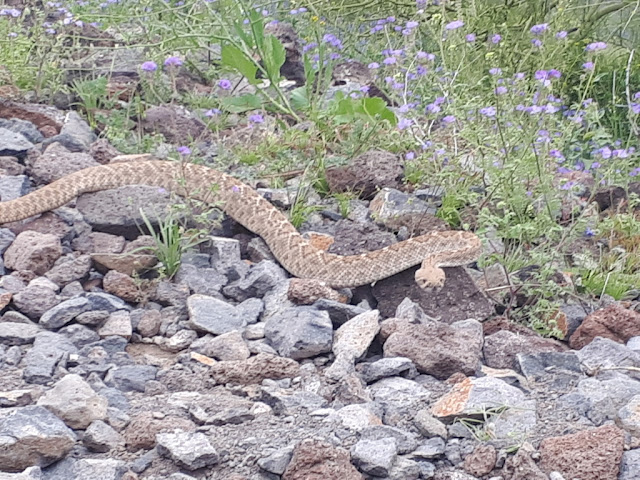A few years ago we chose Massacre Falls in the Superstition Mountains as one of our hiking destinations during our time in Mesa, and especially I really liked that hike. Then, it was a dry spring, the waterfall just a trickle. This year there might actually be a real waterfall since the area had received a lot of rain. We decided to check it out on Wednesday and save the big hike up the Flatiron for the next day.
We were on our own since Aaron and Evelyn went to a ballgame, but the instructions for the trailhead were pretty clear both from our online research and what we could find out in “60 Hikes Within 60 Miles of Phoenix”. We needed to go just past the entrance to Lost Dutchman Park, and the trailhead would be about a mile further on the right hand side. Parked cars in the small parking lot showed that we had arrived at our destination, and, armed with water and a few snacks we were on our way. There were no signs, and the trail split shortly after we started out, but it would be logical to take the wider of the two trails, wouldn’t it? The trail meandered through the valley for a good while without gaining much elevation before turning left and climbing a bit. We crossed “Jacob’s Cross Trail”, named, just like the Lost Dutchman Park itself, after the German prospector Jacob Waltz who mined for gold in this area in the 1890s.
Somehow this trail started to look quite different from what we remembered. We should have left the flats by now. Had we taken a wrong turn? We were not going to turn around, however, and kept going in the direction where we assumed the waterfall to be. With any luck we’d get to the right trail again after a while. Soon it became apparent that this was not going to happen if we continued on. We needed to gain elevation and keep roughly going east. When we were straight below the impressive rock formation called the “Praying Hands” – this is truly what they look like – we followed a not very well defined trail and, since we found a few small rock cairns, were somewhat reassured: somebody must have hiked here before. Soon, however, the trail disappeared completely. There was nothing for it: we’d have to climb up the rocky draw to reach the trail leading east from the Praying Hands. We were still hoping to keep going east and eventually arrive at the falls. It was pretty hard work climbing up the draw, but every break to catch my breath rewarded me with the amazing view of the Superstition Mountains stretching into the distance. Spring flowers were in bloom, and the hillsides were green with new growth, greener than we had ever seen them before.
We arrived at the trail east of the Praying Hands just as a group of women walked up from the west. Would they be able to tell us if we could get to Massacre Falls this way? The leader, obviously well familiar with the area, thought we might be able to but said she had never accessed it from here before. Well, we’d just keep going as far as we could; maybe we would be lucky. If we followed the loop we would pass "Slot Rock", another massive rock formation, and then head back to the parking lot.
When we got to the next butte (I think the woman we talked to called it ‘The Gargoyle’) we kept going east for a while longer, following the hardly visible trail, but when we lost it again and came to yet another draw that would be difficult to traverse we gave up: there would be no Massacre Falls for us this time. We turned around and kept following the much better marked trail that looped towards Slot Rock, marvelling at these massive rocks that seem to have shouldered their way straight out of the desert. What gorgeous country this is!
The hillsides were purple with nodding onions, and the poppies, their golden blossoms folded on this mostly cloudy day, would surely be in bloom as soon as the sun came out.
After maybe another mile or mile and a half we arrived back at our car. Only now, when I read more about Massacre Falls, did I find out that the trailhead is no longer where it had been until about two years ago but has been moved. Had we researched a bit more beforehand we very likely would have found the elusive falls. It doesn’t matter: every hike here is rewarding, and there is so much more of the Superstition Mountains that we haven’t yet seen.






























